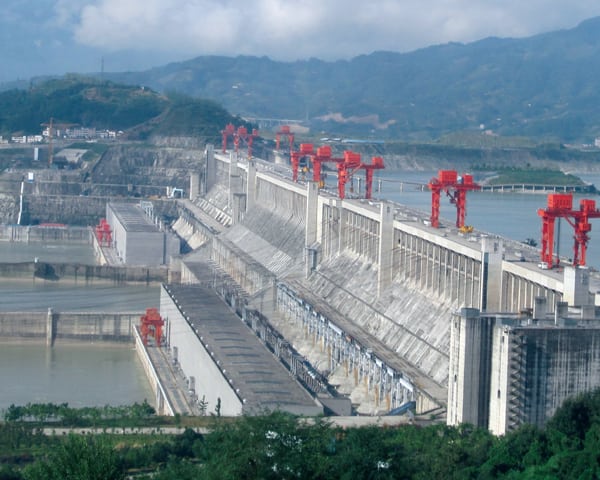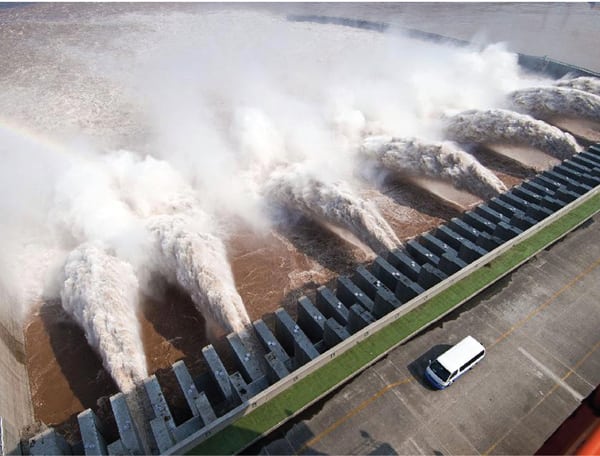TOP PLANT: Three Gorges Dam, Yangtze River, Hubei Province, China
 |
| Courtesy: Le Grand Portage |
Owner/operator: China Yangtze Power Co., Ltd.
After nine years of construction, installation, and testing, the Three Gorges Dam is now complete. On May 23, 2012, the last main generator finished its final test, increasing the facility’s capacity to 22.5 GW and making it the world’s largest capacity hydroelectric power plant.
It’s fitting that the Three Gorges Dam (TGD) achieved full commercial operation in 2012, the Year of the Dragon, based on the Chinese zodiac. The dragon sign represents accelerated risk-taking and breaking through outmoded paradigms. Through hard work and tenacity, the pioneering TGD developers and their staff overcame many obstacles to create an immense hydroelectric facility. Since the TGD was started almost a decade ago, it has set several world records in hydropower construction and achieved a series of technology breakthroughs, thanks to continuous scientific and technical advances.
Located in the Xilingxia Gorge area, one of the three gorges of the Yangtze River, the dam controls a drainage area of 1 million square kilometers (km2), with an average annual runoff of 451 billion cubic meters (m3). The TGD is made of 14.86 million m3 of concrete, is the biggest structure of its type in the world, and is visible to astronauts in the International Space Station.
The Project’s Construction History
As the legal entity in charge of the TGD, the China Three Gorges Corp. (CTGC) has had full responsibility for the TGD’s financing, construction, and operation, according to CTGC sources. The CTGC was set up as a state-authorized investment institution, which was allowed to use Chinese state funding for the project. In September 2002, the CTGC established the subsidiary China Yangtze Power Co., Ltd. (CYPC), which was assigned to manage both the TGD and the Gezhouba hydropower plants. The $30 billion cost of the TGD project will be repaid by revenues received from the sale of electricity.
On Dec. 14, 1994, TGD construction formally started. On Nov. 8, 1997, the river closure was completed as part of Phase 1. In 1998, Phase II construction of the TGD went in full swing, and six years later, on June 1, 2003, the TGD’s reservoir started storing water. Next, on June 16, 2003, the TGD’s double-lane five-step shiplock was put into service. Then on July 10, 2003, the first 700-MW generator was connected to the grid and began to generate electricity. The last unit entered service in May 2011.
Facility Highlights
Now fully operational, the TGD has a total of 34 generators: 32 main generators, each with a capacity of 700 MW, and two plant power generators, each with capacity of 50 MW, for a total capacity of 22.5 GW. Of those 32 main generators, 14 are installed in the north side of the dam, 12 in the south side, and the remaining six in the underground power plant in a mountain south of the dam.
The first units were manufactured through two joint ventures (JVs) followed by units manufactured by Chinese companies based on extensive technology transfer requirements. The first JV consists of Alstom, ABB Group, Kvaerner (which supplied eight units), and the Chinese company Harbin Electric Machinery Co. Ltd. (HEC). The other JV includes Voith, General Electric, and Siemens (abbreviated as VGS and which supplied six units) plus the Chinese company Dongfang Electrical Machinery Co. Ltd. The technology transfer agreements were signed together with the equipment supply contracts. For example, as part of their agreement, HEC produced 14 units in all (eight on the project’s left bank, four on right bank, and two underground), with the final two units produced almost completely in China. CTGC later contracted with Alstom for the supply of four additional units.
The TGD uses Francis turbines with a diameter that is 9.7 m or 10.4 m (VGS design/Alstom design) and a rotation speed of 75 revolutions per minute. The turbine generators’ rated power is 778 MVA, with a maximum of 840 MVA and a power factor of 0.9. Most of the TGD’s generators are water-cooled. Some newer ones are air-cooled, which are simpler in design and easier to maintain.
Several technology breakthroughs were made during generator installations: automatic welding on the large stator assembly, lamination stacking of a large stator in the field, welding and measurement of rotor roundness, and controlling the roundness of rotor rim and plate.
The speed of the units’ installation was impressive. For example, in 2003, the project team installed and put into operation six 700-MW units, which set a new world record for yearly installation of large-size turbine generators. Monitoring data showed that all the units that had been put into operation worked steadily and met the design requirement of various technical parameters.
During the annual dry season that occurs from November to May, power output is limited by the river’s flow rate. On the flip side, when there is enough water flow, power output is limited by plant generating capacity. The TGD reached its design-maximum reservoir water level of 175 m for the first time on Oct. 26, 2010, when generation capacity of 84.7 TWh was realized.
By Aug. 16, 2011, the plant had generated approximately 500 TWh of electricity. Now that the TGD is fully operational, annual generation is projected to be more than 100 TWh. Currently, the facility’s electricity is sent to Central China, East China, Guangdong, and Chongqing with a maximum transmission range of 1,000 km. Nine provinces and two cities consume power generated by the TGD (Figure 1).
 |
| 1. Dealing with a deluge. On July 24, 2012, flood water was released from the Three Gorges Dam, the 22.5-GW hydropower project on the Yangtze River in central China. Because of heavy rains in the upper reaches of the river, the facility experienced its largest flood peak during 2012 with a peak flow of 70,000 cubic meters of water per second. Courtesy: Xinhuanet |
Originally, the TGD was intended to meet 10% of China’s power needs. However, demand has increased more quickly than the Chinese government initially projected. For example, the TGD supported only about 1.7% of the country’s electricity demand in 2011, when demand reached 4,692.8 TWh.
Environmental Effects
Compared to coal-fired power stations producing the equivalent level of generation, the TGD will avoid creating the following pollutant amounts, according to CTGC sources:
- 100 million tons of carbon dioxide
- Two million tons of sulfur dioxide
- 0.37 million tons of nitrogen oxide
- Large quantities of wastewater and solid waste such as coal ash
The TGD will improve China’s air quality by not creating contaminants that cause acid rain and greenhouse effects in East and Central China. In addition, hydropower saves the energy needed to mine, wash, and transport coal from northern China.
Despite such accomplishments, some critics assert that the huge hydroelectric facility is having the following negative impacts on the environment:
- Wastewater collection increased. More than one billion tons of wastewater are released annually into the Yangtze River, which in the past was moved downstream before the river was dammed and the reservoir was created. Now the water in the reservoir appears stagnant and polluted.
- Decrease in forest cover. The Three Gorges, especially in the Yangtze Basin upstream from the Three Gorges Dam, currently has 10% forestation, down from 20% in the 1950s.
- Loss of wildlife. The region provides habitats for hundreds of freshwater and terrestrial animal species. Some of the species that have been negatively impacted by the TGD include Chinese (Baiji) river dolphins, Siberian cranes, and Yangtze sturgeon. Freshwater fish are especially affected by dams due to changes in the water temperature and flow regime. Many fish are injured in the turbine blades of hydroelectric plants as well.
- Increased erosion and sedimentation. At current levels, 80% of the land in the area is experiencing erosion, depositing about 40 million tons of sediment into the Yangtze River annually because the flow is slower above the dam. Much of the sediment will now settle there instead of flowing downstream, and there will be less sediment downstream.
Controlling Floods
The Three Gorges Dam project is designed to adjust the Yangtze River’s upstream flood, which will ensure successful flood control of the Jingjiang section, CTGC sources say. The project’s goal is to prevent 10-year floods and control 100-year floods of the Yangtze River. Even in the rare case of a 1,000-year flood, mass damages or injuries can be prevented, according to the CTGC.
At the same time, serious problems—such as environmental degradation and disease epidemics related to floods or flood diversion—will also be avoided. Thus, the project will protect 1.5 million hectares of farmland and towns and 15 million people from flood damage in the Jianghan Plain and the Dongting Lake area.
— Angela Neville, JD is POWER’s senior editor.